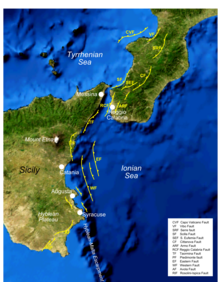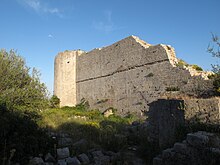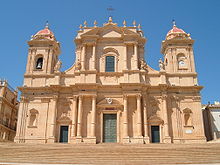1693 Sicily earthquake
Intensities of VIII or higher have been estimated for Augusta, Avola Vecchia, Floridia, Melilli, Noto Antica, Catania, Francofonte, Lentini, Scicli, Sortino and Vizzini.(see main article on the Malta Escarpment[8] Historic documents in the Archivo General de Simancas mention dozens of aftershocks, some as late as August 1694, and some reportedly as strong as the initial quake of 11 January 1693.At Ognina, just south of Syracuse, at the head of a ria, a sequence containing several coarse clastic layers has been found, inconsistent with its lagoonal setting.Following detailed analysis of both grain size and foraminifera assemblages, eleven possible high-energy events were found based on the presence of large numbers of shallow water forams combined with a greater proportion of fine sand in the same interval.At least 70 cities, towns and villages were devastated, with some examples of at least partial building collapse as far afield as Messina, Agrigento, Palermo, Reggio Calabria and Malta.In the same area, sand volcanoes were formed by jets of water spurting as much as several metres into the air, with similar phenomena being reported from the Lentini plain and along some river valleys.Due to illness, both the Prince of Aragon and his replacement the bishop of Syracuse were unable to take up the position of Vicar General for Val di Noto and the Duke of Camastra was forced to take on the responsibility for both areas.[5] Amongst other administrators sent to the damaged area was Colonel Don Carlos de Grunenbergh, royal engineer to the King of Spain, who had experience in planning and building fortifications.[5] The initial reconstruction efforts concentrated on restoring the military defences of Syracuse, Augusta, Catania and Acireale, due to their strategic importance.[10] The degree and extent of the damage caused by the earthquake prompted an architectural revival in the towns of Sicily and Malta, a style that has become known as Sicilian Baroque.Towns that suffered serious damage from the earthquake in which many of their structures were rebuilt, include Syracuse, Ragusa, Catania,[23] Caltagirone, Palazzolo Acreide, Modica, Comiso, Scicli and Mdina on Malta.



Sicilysouthern ItalyCrown of AragonKings of SpainCalabriaforeshockmoment magnitude scaleMercalli intensity scaleIonian SeaStraits of MessinaCataniaepicentreVal di Notohomogeneous late Baroque stylePhilosophical Transactions of the Royal Societyconvergent boundaryAfrican platesubductingEurasian platestratovolcanoMount EtnaSiculo-Calabrian riftextensional faultingHyblaean Plateau1783 Calabrian earthquakesQuaternaryhalf-grabensAugustaAvola VecchiaFloridiaMelilliNoto AnticaFrancofonteLentiniScicliSortinoVizziniBuscemiOcchiolaHyblean-Malta escarpmentMalta EscarpmentArchivo General de SimancasMascaliTsunami depositsgravity coreforaminifera1908 Messina earthquakeeruption of 1669Coulomb stress transferRagusaSyracuseMessinaAgrigentoPalermoReggio Calabriasand volcanoesKnights of MaltaModicaMalletSicilian BaroqueViceroyDuke of UcedaGiuseppe LanzaVicars GeneralCarlos de GrunenberghVincenzo Sinatracathedral of MdinaBaroqueCaltagironePalazzolo AcreideComisoUNESCOWorld Heritage SiteList of earthquakes in ItalyList of historical earthquakesWayback MachineJuan Francisco Pacheco y Téllez-Girón, 4th Consort Duke of UcedaViceroy of SicilyBibcodeGeophysical Journal InternationalRoyal Astronomical SocietyEarthquakes in Italy62 Pompeii1117 Verona1169 Sicily1222 Brescia1343 Naples1348 Friuli1456 Central Italy1570 Ferrara1626 Girifalco1627 Gargano1638 Calabrian1639 Amatrice1659 Calabria1688 Sannio1694 Irpinia–Basilicata1703 Apennine1706 Abruzzo1732 Irpinia1743 Salento1783 Calabrian1805 Molise1857 Basilicata1873 Alpago1883 Casamicciola1887 Liguria1905 Calabria1907 Calabria1908 Messina1915 Avezzano1916 Rimini1920 Garfagnana1930 Irpinia1930 Senigallia1936 Cansiglio1962 Irpinia1968 Belice1971 Tuscania1976 Friuli1980 Irpinia1990 Carlentini1997 Umbria and Marche2002 Molise2009 L'Aquila2012 Northern Italy